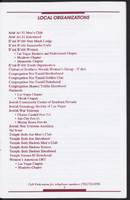Search the Special Collections and Archives Portal
Search Results
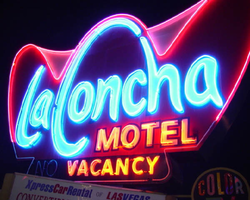
Photographs of La Concha sign, Las Vegas (Nev.), 2002
Date
Archival Collection
Description
Site address: 2955 S Las Vegas Blvd
Sign owner: Edward Doumani
Sign details: The La Concha is located north of the Riviera hotel Casino, just past the giant glass wall advertising for Splash. The La Concha double sided ground sign, sits close to the street on the east side of the strip, facing north /south. Directly to the east the origin of the signs shape resides in the form of the front structure of the La Concha's lobby structure. The sweeping elliptical roofline creates a structure dripping with the flavor of outlandish 50's-60's expressionistic modern design. The roadside ground sign reflects this shape actually mimicking it in a stylized silhouette of itself. The two icons are separated by a small but busy parking lot that expands north of the La Concha to house other similar style structures. The wings of the hotel, which extend out behind the main lobby, are a rather stark and plainly rectangular form, compared to the front portion of the lot.
Sign condition: Structure 4 Surface 4 Lighting 4 Notes: Considering the age of the property and the sign, it is in great condition, everything is intact, but not perfect.
Sign form: Pylon
Sign-specific description: The sign resides in a pleasant spot of green grass, among the concrete and black top surfaces. A rectangular base, painted a light hue of blue and gold, supports a double-sided sculpted cabinet in a three-pointed crown, which is the stylized profile of the building in sits in front of. Below the main cabinet a triangular internally lit message center has been added, as well as two more, flat rectangular cabinets on the north and south sides. The cabinets are adorned with text that advertising for car rentals located in the same neighboring lot. Off of the west side of the cabinet a small circular cabinet is cantilevered off of the edge. It is an internally lit marker, noting that color television is available inside. The surface of the actual cabinet is painted red, and is somewhat faded. The section of the cabinet that would be dedicated to the low-lying portions of the La Concha's roof are addressed in white. The "La Concha" is spelled across the front of the sign in white text outlined in blue. The text is designed specific to the sign, for the capital L and C are shaped to match the contours of the crowns of the sign. The rest of the script also takes on some of the same stroke of the manner. Motel is spelled in the same coloring across the bottom right hand portion of the signs face, in block text. The very bottom portion of the cabinet is a black painted horizontal extension with edges that angle back into the body of the sign. The words "vacancy' are written across the surface of the sign to the right hand side. No is spelled on the left, but only in neon. When illuminated the main text is lined with a light electric blue, while the edges, and the top contours are lined with a pink and fuchsia glowing borders. The words "vacancy" and "motel" are lined in an orange, amber colored, warm tubing.
Sign - type of display: Neon; Incandescent; Backlit
Sign - media: Steel; Plastic
Sign - non-neon treatments: Graphics; Paint
Sign animation: none
Sign environment: The La Concha sits just to the south of the Riviera's giant glass wall. Headed south, the property comes into view, being a quiet transition from the extreme nature of the Riviera. The sign sits in a black top expanse that meanders back into the rest of La Concha's property. The base of the sign is surrounded with plants and curbing, firmly rooted into the urban mainstream of the neighboring street.
Sign manufacturer: YESCO
Sign - thematic influences: The theme of the La Concha can be drawn directly from 1950's and 60's modern design. Such curve can be seen signs of the decade for example the original Dunes pylon displays elements of such curve and swell. In Jorg Rugemer's Lost Las Vegas, there is a picture of a 60's era automobile sitting next to the building. It is used to show the influences of the structures design present in the design of something as common as the automobile. It is reminiscent of the protruding fins and large eye like taillights seen on such autos. The sign itself is an interpretation of the building in a silhouette form, so it's angle draw from the same pool as well. The coloration of the neon is also reminiscent of the era. The turquoise, vermilion and red are reminders of such properties as the original Flamingo, and the Algiers.
Surveyor: Joshua Cannaday
Survey - date completed: 2002
Sign keywords: Pylon; Neon; Incandescent; Backlit; Steel; Plastic; Graphics; Paint
Mixed Content
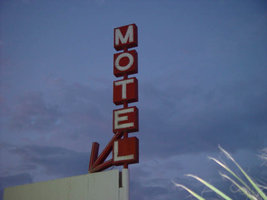
Photographs of Happi Inn signs, Las Vegas (Nev.), 2002
Date
Archival Collection
Description
Site address: 3939 S Las Vegas Blvd
Sign details: The Happi Inn resides on the corner of Mandalay and Las Vegas Blvd, stretching east, ending at Gilles street. The property is the largest of the small roadside sites. The signage, however, is limited. Three pole signs and an internally lit cabinet comprise total signage. The two pole signs, being the tallest, reside on the north end of the property while a small vertical pole sign resides on the top of the building's roofline. The small internally lit cabinet sits over the drive, next to the main office.
Sign condition: Structure 3 Surface 4 Lighting 3 Notes: The structure of all the signs appear to be intact, with no visible, severe damage. Various lighting is out an all the signs, with the small roof line pole sign, no longer being lit. The internally lit cabinets on the sign within the pole sign furthest east, are no longer lit as well. The surfaces of the sign are intact, but are worn.
Sign form: Pylon; Fascia
Sign-specific description: Two pole style pylons, reside on the north end of the property. On the rear of the property on the corner of Mandalay Bay and Gilles Street, is a simple design. A single white, steel pole, supports three, two- sided cabinets stacked on top of each other to create the shape. A small white, horizontal, rectangular, cabinet, has a white face with "Office" painted in red text, and a red arrow pointing to the west. It sits slightly off center the center pole. A tall, thin, vertical, rectangular cabinet, is painted orange, and has the world "Motel," spelled in all capital, white neon letters. Centered on top of this cabinet, another internally lit cabinet, white cabinet, crowns the sign. The cabinet has a green face with white text spelling "Happi Inn" in all capital letters. The main pole sign for the property is similar to the previous piece, but a bit more elaborate. As the white pole rises up from the ground it is met with a pair of black, cabinets, sandwiching the north and south sides of the pole. The sign itself faces north south. The cabinets are white faced with text painted upon the surface. Above the two cabinets, a double-backed cabinet is crafted into an "L" shape, facing north, and facing south it would be a "J" shape. Either way it is a horizontal cabinet, which makes a horizontal turn to the east. The foot of the character curves down to a point, while the vertical section, runs up the west side of the white pole, which continues upward. The vertical surface contains the text "Motel" that is written horizontally downward in all capital, white, painted text. The graphic text is shadowed over with neon tubing. The horizontal section has the words "vacancy" written in white all capital text, with red neon lying over the surface. The top of the sign is crowned with a double backed, six sided, geometric cabinet. The surface is green written in capital, white text, with the word "Happi" written in an arched pattern, with "Inn" written horizontally below that. Over the entrance to the driveway, stretching into the east-end of the lot, is a small, internally lit cabinet, with rounded ends. The face of sign is green plastic with "Happi Inn" written in all capitals, in a two lined text. White, scroll-type designs, flank, both sides of the text. Just past the Psychic Sessions, palmistry establishment, actually standing on the corner of the building, a vertical pole sign, rises in the sky. I single red pole shoots upward a short distance, with five double-backed square cabinets being speared through the center. Each cabinet, also red, contains 1 letter from the word "Motel, in all capitals." The letters are overlaid with neon as well/ Pointing down toward the property, an angled arrow, crafted in the same fashion and material as the cabinet, is positioned just below the east side of the cabinet containing the letter "E."
Sign - type of display: Neon; Incandescent; Backlit
Sign - media: Steel; Plastic
Sign - non-neon treatments: Paint
Sign animation: Chasing, flashing, oscillating
Notes: the letters inside of the letters of the tower actually oscillate.
Sign environment: The Happi Inn is part of the distinctive section of the Strip comprised of older roadside motels, met with a few of the larger resort casinos. Facing west on the corner of Las Vegas Blvd and Mandalay Rd., the property resides in the shadow of Luxor. To the north, vacant land reaches until ended by the Tropicana property.
Sign - thematic influences: There appears to be no apparent theme associated with the Happi Inn other than the fact that it belongs to the style and genre of the roadside motel design seen throughout the southern end of the strip.
Surveyor: Joshua Cannaday
Survey - date completed: 2002
Sign keywords: Chasing; Pylon; Fascia; Neon; Incandescent; Backlit; Steel; Plastic; Paint
Mixed Content
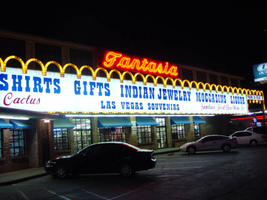
Photographs of Fantasia signs, Las Vegas (Nev.), 2002
Date
Archival Collection
Description
Site address: 2800 S Las Vegas Blvd
Sign details: Fantasia on the Strip is located north of the Circus Circus, among the smaller properties located the northern end of the Strip before Sahara Avenue. The building faces east, only separated from the street by a small parking lot, which runs along the front of the property. The two-story building is adorned with a building length message cabinet, and sculpted, patterned raceways. The sign extends north across a drive designating parking in the rear. A small pole sign also sits on the east edge of the property.
Sign condition: Structure 3 Surface 4 Lighting 4 The Fantasia establishments signage looks decently weathered up close, for the colors and paint treatments are in good condition. The structure of the sign has a couple of anomalies that are apparent. The pole sign on the street side of the property has no face on the triangular portion of the surface. The far right hand side of the building fascia makes an uncomfortable transition into the support structure from the ground.
Sign form: Pylon; Fascia
Sign-specific description: The design is a building front, message cabinet running the length of the facade of the building, facing east. The white, steel, paneled front cabinet contains Blue and red plastic text. The larger fonts run the entire length of the sign and read "Souvenirs, T-shirts, Gifts, Indian Jewelry, Moccasins, Liquor," in an "old west" style text seen on properties such as the Frontier. This arrangement's color is blue. The bottom line of text is smaller and is broken up into three separate phrases and distributed evenly across the surface. The left side reads, " Jewelry, Belts, Hats, Cactus" in red cursive. The center is blue western font, reading "Las Vegas Souvenirs." The right hand side is red cursive again reading "Sundries, Food, Beer Wine, Ice." The bottom and top edges are lined with yellow raceways with incandescent bulbs. The top edge is created by a repeating series of raceway arches, matching the finish of the other edges. The top edge of repeating arches continues north past the edge of the cabinet onto a smaller, much thinner cabinet. The thinner cabinet looks as is if it is a continuation of the main sign with pieces cut out of it. The arches continue to the end of the extension and down connecting to a steel I-beam linked to the ground. The smaller plane reads "park in rear" in red, plastic, all capital, letters. Raceway arrows protrude through the bottom of the sign, pointing through the entrance it creates for traffic. The arrows are arranged on the bottom edge as if they are extensions of the imaginary points created by the meeting of the downward strokes two sides of two arches. Across the very top of the main banner, a narrow, red, steel cabinet reads the word "Fantasia" in white script. The script is surfaced with neon. Near the street, on the northern portion of the property, a pole sign holds an internally lit cabinet. The frame of the cabinet is a blue raceway whose western edge is fashioned into an arrow shape. White plastic comprises the face of the sign, which faces north south, and does not reach into the arrow section. It is a skeleton of a frame, with nothing in the middle. Translucent vinyl lettering is present on the face of the sign and reads "Liquor, Moccasins, Indian Jewelry 1/2 off," in all capital letters.
Sign - type of display: Neon; Incandescent; Backlit
Sign - media: Steel; Plastic
Sign - non-neon treatments: Paint
Sign animation: Chasing
Notes: The only animation present is the animation of the incandescent bulbs on all the raceways surrounding the signs. The bulbs chase each other from left to right.
Sign environment: The fueling station resides on the northern edge of the strip before Sahara Avenue. Directly to the east, across the street is the Sahara Hotel Casino, but is flanked by smaller non-resort related properties. Along with the other two properties to the north and to the south, they seem as functional aspects for tourists and patrons of the larger properties of the Circus Circus and the Sahara. Almost dwarfed by the two nearby giants the properties can easily go unnoticed without the treatment of the illumination.
Sign manufacturer: YESCO
Sign - thematic influences: There is no real theme associated with the property other than being a typical Las Vegas strip shopping establishment. The unique array of raceways and chasing incandescent bulbs are reminiscent of the countless canvass of the same design technique seen all of the strip, yet retain a hint of originality with it's arched pattern. Another widely used element , present in the design, is the internally lit message center. These two simple elements are used in conjunction to create a unique display typical to the Las Vegas Strip. It fits into the context of the Las Vegas strip as one of the many gift shops, but stands out as one of the larger ones, with the most vibrant signage.
Surveyor: Joshua Cannaday
Survey - date completed: 2002
Sign keywords: Chasing; Pylon; Fascia; Neon; Incandescent; Backlit; Steel; Plastic; Paint
Mixed Content
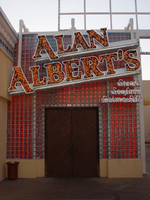
Photographs of Alan Albert's signs, Las Vegas (Nev.), 2002
Date
Archival Collection
Description
Site address: 3763 S Las Vegas Blvd
Sign details: Following the alleyway created between the Walgreen's and Fatburger establishments, you can find the entrance to the secluded Alan Albert's. The restaurant is located on the Fatburger (north) side of the drive, found headed east down the south side of the building. The building quickly stretches out to the south and then continues east again. Signage is located on this extension of wall. The signage includes a logo wall sign, a neon back-lit glass block wall, as well as three small steel boxes adorned with crafted neon. Signage is also located on the Walgreen's dominated pylon out front.
Sign condition: Structure 5 Surface 4 Lighting 5 Note:The structure of the sign is intact, and appears to be complete in all its parts. The surface of the sign is worn by the weather, but no worse than any other property.
Sign form: Fascia
Sign-specific description: The small face created by the south extension creates the space for the entrance to Alan Albert's. The sign hangs off this wall above a pair of large wooden doors, created with brown painted channel letters in a text specific to the establishment. They are painted white on the exterior. The channel letters are steel, outlined with white neon and filled with incandescent bulbs. White neon tubes underline each word. Almost the entire wall is created of translucent glass blocks. Behind the glass blocks there are tubes of red neon running vertically and horizontally along the open sections of the blocks create a glowing background grid of red light. The entire sign is supported with steel brackets, which are hung from the top of the roof hooking onto the wall of the building. The letters are hung at an angle pointing from the bottom toward the top right hand corner of the building. Below the main text on the right hand portion of the sign are three horizontal steel boxes hung consecutively, supporting text sculpted out of neon. The top box reads "Steaks," the second reads "Seafood," and the third reads "Prime-rib." On the Multi-use pylon the Alan Albert's signage only plays second fiddle to the dominant Walgreen's sign. It is four lines of text with the two lines of "Alan Albert's" filling the top spots. Below that "steaks, seafood, prime rib," sits above the text "so delicious intimate." The top two lines are spelled in brown channel letters, filled with incandescent bulbs, and bordered on the face with red neon. A narrow polished channel underlines each line of text and is lined with a single tube of white neon. The bottom two lines of text are smaller script channel letters lined with red neon. Below this collection of letters and bulbs, a backlit selection of signs also adds to the list. "Lobster House" is spelled in closed channel letters with red faces. A narrow internally lit green cabinet, with rounded ends, is treated with white script.
Sign - type of display: Neon; Incandescent; Backlit
Sign - media: Steel; Plastic; Glass
Sign - non-neon treatments: Graphics; Paint
Sign animation: Oscillating
Notes: The incandescent bulbs inside the interior of the main text, oscillate rapidly. The effect is the shimmering effect seen so often throughout neighboring properties. It can be seen in the main building texts of properties such as the Monte Carlo and the Mirage. The Alan Albert's text on the Walgreen's pylon near the street is animated as well. The incandescent bulbs animate with an oscillating pattern steady burn on, then flash off, then on, off then starts to oscillate once again.
Sign environment: Alan Albert's sits tucked away from the bustle of the main street, guarded on both sided by Walgreen's and the Fatburger establishments. Besides the adjacent archway advertising for the Ginseng BBQ establishment, the signage for the Alan Albert's is the main attraction in the immediate space.
Sign manufacturer: YESCO
Sign - artistic significance: The significance of the Alan Albert's establishment fits in with other facilities on the Strip such as The Rosewood Grill, and Battista's Hole in the Wall, and the Peppermill. Considering that most dining establishments are located on the interior of the properties, these stand as excellent quality, intimate restaurants seen by and available to the pedestrian public. Like the everyday establishments dressed to fit in the Las Vegas Strip such as the neighboring Walgreen's, Alan Albert's is a non-casino dressed up to fit in with the local surroundings. The incandescent bulbs also contain the most common animation seen on the strip. The surface of the wall is turned into a blurry illuminated canvas with glass block wall, backed by a grid of red neon. The surface is a one of a kind for the properties in this survey and the genre that it represents.
Surveyor: Joshua Cannaday
Survey - date completed: 2002
Sign keywords: Oscillating; Neon; Incandescent; Backlit; Paint; Graphics; Steel; Plastic; Glass; Fascia
Mixed Content
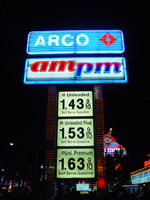
Photographs of Arco ampm sign, Las Vegas (Nev.), 2002
Date
Archival Collection
Description
Site address: 2728 S Las Vegas Blvd
Sign details: Amid the few smaller properties that compose the area north between the Circus Circus and Sahara Boulevard, the Arco AM/PM is located on the west side of the Strip between the Guiness/Arby's parking lot to the north and the Fantasia gift shop to the south. Like many other everyday institutions located on Las Vegas Blvd, it's roadside advertisement fits into the neon picture with ease. The structure itself is nothing like the treatment of the pylon, which sits on the eastern most edge of the property, in close proximity to the street. The actual mini-mart, customer facility is located in the background, on the western end of the lot, and faces east. The standard array of fuel pumps occupy the majority of the remaining space on the lot.
Sign condition: Structure 4 Surface 4 Lighting 4 notes: The structure, surface and lighting all are around the same condition. Several neon bars have come loose at the base of one of the legs, and the neon on the north side of the pylon is not functioning properly. The surface of the sign is in good shape, in need of a thorough cleaning.
Sign form: Pylon
Sign-specific description: The pylon sign for Arco AM/PM resides on the southeastern corner of the property, near the street, sitting in a planter of rocks. It sits on the west side of the strip, and faces north/south. The basic shape of the double-backed roadside pylon is a simple design, similar to any other sign at a typical gas station. Two square posts support a cabinet wider in diameter with the lettering and logos for the property. Between the two posts are three, descending, square, internally lit, message boards, advertising the price for gas. It stands in a bed of rocks, in close proximity to the street and faces north/south. The two legs are finished in a polished, silver, reflective surface. The three internally lit, white plastic, cabinets advertise for the prices of fuel, and begin approximately six feet or so from the ground up into open space inside the legs. At this height, neon wraps the poles, creating a pattern up the sides. Tubes of white neon wrap the three outer sides of the pole, repeating every two inches or so, striping the surface. The legs actually support two smaller cabinets stacked on top of each other to create a larger surface. The two cabinets are the same in general dimensions with the top section having rounded corners. The bottom cabinet is black on the exterior with the inner face a giant white channel pan lined horizontally with tubes of white neon. Two sets pan channels are set onto this field. The first is the two letters "am" and the other being the finishing portion "pm" The "am" section is painted two-tone orange and red, and the "pm" is a two-tone purple and blue. The letters are lined on the inside edge with neon. The white field is bordered in neon as well. The top cabinet is a blue pan channel lined horizontally with blue neon. White channel spell "Arco" in the middle of the field, and four triangular shapes converge to form the diamond shaped Arco symbol.
Sign - type of display: Neon; Backlit
Sign - media: Steel; Plastic
Sign - non-neon treatments: Graphics; Paint
Sign animation: Chasing
Sign environment: The fueling station resides on the northern edge of the strip before Sahara Avenue. Directly to the east, across the street is the Sahara Hotel Casino, but is flanked by smaller non-resort related properties. Along with the other two properties to the north and to the south, they seem as functional aspects for tourists and patrons of the larger properties of the Circus Circus and the Sahara. Almost dwarfed by the two nearby giants the properties can easily go unnoticed without the treatment of the illumination
Sign manufacturer: Larsen Sign
Sign - date of installation: 31758
Sign - thematic influences: The property and sign has no real thematic influence other than being an everyday facility influenced by its environment. The surroundings of abundant neon influence the sign to its treatment in order to have an impact.
Sign - artistic significance: The sign is significant artistically for it represents a piece of everyday life, dressed up to fit in on the Las Vegas Strip. The structure of a two-legged pylon so often seen at other non neon treated gas stations is the same, yet the coat of neon turns it into a unique piece of the Las Vegas strip. Other facilities seen with the same treatment are the Walgreen's, Arby's, McDonalds, and Fatburger.
Surveyor: Joshua Cannaday
Survey - date completed: 2002
Sign keywords: Chasing; Pylon; Neon; Backlit; Steel; Plastic; Paint; Graphics
Mixed Content

Transcript of interview with Bruce M. Eaton by Jay Brewer, April 24, 1975
Date
Archival Collection
Description
On April 24, 1975, Jay Brewer interviewed Bruce M. Eaton (born 1904 in Toronto, Kansas) about his life in Nevada and more specifically on the growth of Boulder City. Eaton first talks about his family’s move to Nevada and his work as a laborer for Six Companies during the construction of the Boulder Dam and his eventual employment with the Bureau of Reclamation as a general foreman. He also talks about the work conditions on the Boulder Dam, including the protection by Army personnel during the time of World War II. Eaton also describes the details of a federal investigation involving Eaton, a case of suspected espionage, and some of the racial conflicts that existed at the dam. Eaton then discusses his enlistment into the United States Navy and the incident that led him to be medically discharged before a deployment. He then describes the role of several Nevada legislators in helping the growth of Boulder City and his interactions with them. Eaton then discusses his role as city manag
Text
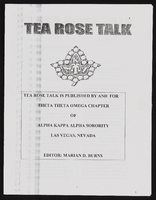
Alpha Kappa Alpha Sorority, Theta Theta Omega Chapter "Tea Rose Talk" newsletters
Date
Archival Collection
Description
From the Alpha Kappa Alpha Sorority, Incorporated, Theta Theta Omega Chapter Records (MS-01014) -- Chapter records file.
Text

Transcript of interview with Lyn Robinson by Barbara Tabach, September 18, 2014
Date
Archival Collection
Description
One day in 2012, UNLV student Lyn Robinson spied a posting on the bulletin board for a photographer for the Sperling Kronberg Mack Holocaust Resource Center. She was an art major with a concentration on photography. She was also had a deep appreciation of the horror of the Holocaust and what the survivors she would take photos of had endured. Thus began a two year project, during which she took photos of over sixty survivors. Her images are preserved at UNLV Special Collections & Archives. Prints are displayed at the Sperling Kronberg Mack Holocaust Resource Center. On September 18, 2014, Lyn shared her work for this oral history recording. She is a native of Florida, daughter of a horticulturist father and pianist mother.
Text

Transcript of interview with Robert M. Fisher by DeeAnn Coombs, March 20, 1978
Date
Archival Collection
Description
Text

